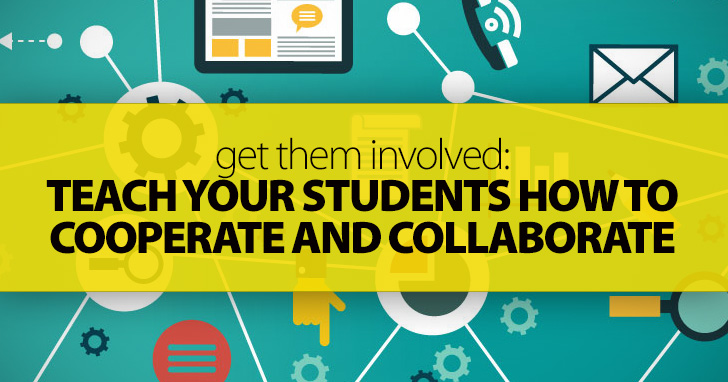Cooperation and collaboration are key, not only in second language learning but in any classroom and household for that matter.
It is one the first things kids learn to do in kindergarten and preschool, and it's no surprise. When children work together in small groups, they can share strengths and also develop their weaker skills. Also, they develop their interpersonal skills and learn to deal with conflict. When they cooperate and are guided by clear objectives, students participate in different activities that improve their understanding. In today's world where being a "team player" is often a key part of business success, teaching children to cooperate and collaborate from an early age is very useful and important. Take a look at some of the benefits of cooperation and collaboration in the ESL classroom.
- Since students participate together in groups, they interact and develop interpersonal skills. As students interact, they acquire skills for resolving conflicts or differences when they appear. They learn to relate to fellow learners as they work together on tasks in groups. This is particularly beneficial for students who have difficulty with social skills. Also, because learning to communicate is essential in language learning, structured interactions can improve communicative abilities.
- Learning to respect others is extremely important, and by learning to respect each other in order to work together, children can acknowledge individual differences. While working together, students will have a variety of responses. This is very positive since it can help the group become aware of a wide range of perspectives which will make their work more complete and comprehensive.
- Children need to be challenged. Through teamwork, challenges are easier to deal with since they can rely on each other to find solutions. Different perspectives provide different and varied alternatives to problem solving.
- Working with others teaches students to value all contributions. Students learn to work with all types of people and diversity is celebrated. Different things like, culture, likes, and personal experiences allow students to add their perspectives to an issue. Students have the opportunity to reflect and this helps students to better understand other cultures and points of view.
- They will have more opportunities for personal feedback on their ideas and contributions because there are more exchanges among students, and they will provide feedback for each other.
Often cooperation and collaboration in learning is not easy to achieve. There are situations in which conflicts that arise obsticalize learning, particularly in situations where students must work together on a problem. As a result, cooperative and collaborative learning require teaching kids to work well with others by resolving these inevitable conflicts. That's why, in order to create an environment in which cooperative and collaborative learning can take place, three things are necessary. First, students need to feel safe, but also challenged. Second, groups need to be small enough that everyone can contribute. Third, the task students work together on must be clearly defined. There are a number of techniques and exercises that you can use. Among the most popular are:

Promote Cooperation in Your Classroom for More Effective Results
-
1
Think-Pair-Share
It is one of the best known and most common exercises used. Students have the opportunity to reflect on the question and then practice sharing and receiving possible solutions. Since it is simple, teachers find it easy to use and adapt to a wide range of course material.
-
2
Interview
This is a great activity to use as an ice-breaker because by interviewing each other children learn about their fellow classmates and can share opinions, positions, or ideas. Students are paired and take turns asking each other questions that can either be provided by the teacher or created by them with supervision. After the interview they can introduce their partner and tell the other students what they know about them.
-
3
Jigsaw
This is great for problems that are more complex. Here, students become experts in one of many parts of a problem. They first participate in a group exclusively focused on a single part of the problem. Later, groups are rearranged with a representative from each expert group who can now manage the whole problem because they have sufficient expertise.
-
4
Peer Editing
Students are paired up and assigned a task. Peers give each other feedback during the completion of that activity. For instance, each student in the pair describes their topic ideas and outlines the structure of their work while their partner asks questions, and develops an outline based on what is described.
-
5
Note-Taking Pairs
For any student, learning how to take notes is important. The reason is that poor note-taking leads to poor performance. A good way to exercise this is by having students summarize what they understood of a concept based on notes they have taken and by getting feedback from their partner. This gives students the opportunity to find gaps in their written records. The note-taking should be guided by questions so students realize what is important.
-
6
Sequences
Graphic organizers are powerful tools that make information meaningful and less complex. In exercises that involve sequences, students can provide a visual representation of a series of events or actions. Students working together can be asked to organize information. They can even be asked how each sequence relates to another.
Cooperative and collaborative learning brings positive results such as deeper understanding of content, increased overall achievement of lesson goals, improved self-esteem, and higher motivation.
Helping students learn to cooperate and collaborate with one another can enable them to become actively and constructively involved in the lesson, to take control of their own learning, and to improve teamwork skills.
P.S. If you enjoyed this article, please help spread it by clicking one of those sharing buttons below. And if you are interested in more, you should follow our Facebook page where we share more about creative, non-boring ways to teach English.







